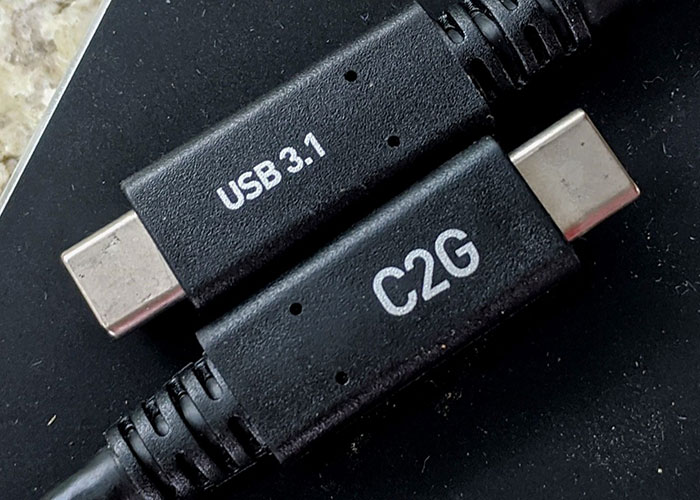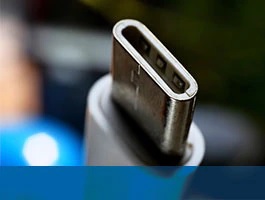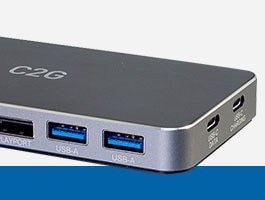What Is USB Type-C?
Posted on 8/24/2020 7:00:00 PM by C2G Team
USB Type-C is one of the most sophisticated and comprehensive connectivity ports to ever exist. Seriously. Unfortunately it is also currently one of the most misunderstood and confusing. There is no easy way to navigate the sea of change engendered by this connector other than vigilance combined with continuing education and experimentation. Consider us your Dark Knight of USB Type-C.
Docking solutions are the bridge between network, productivity, peripheral, and AV systems and solutions. A whole new world of third-party and universal docking stations has been opened by this new USB port! USB Type-C is a small, symmetrical connection that might be found on anything from smartphones and tablets to advanced solid state storage drives and virtual reality headsets. It enables a veritable gourmet menu of technical capabilities, including adaptive power and dynamically assignable channels that can support a smorgasbord of digital payloads. Can you tell we were hungry while writing this? 😊
The USB Type-C connector pin-out has no less than two dozen connection points in a space just over 8mm wide. This sleek connector is tailored to fit mobile device product designs, yet robust enough for laptops and tablets – pretty much anything you connect to a docking station. With a reversible plug orientation and cable direction, USB Type-C supports scalable power and performance to future-proof your solution.

The well-designed docking station is where the versatility and performance promised by this advanced technology is concentrated. The challenge for AV professionals is identifying which docking stations are well-designed and which features are best deployed in a specific installation. For more information on that particular topic, see the white paper linked at the end of this post.
USB Type-C links can support a nominal 40Gbit/s payload total transfer speed across a combination of four parallel Alternate Mode lanes. Each lane can individually support up to 10Gbit/s. Under the DisplayPort 2.0/Thunderbolt 3 interface, which is an emerging USB Type-C option, the total payload transfer speed can reach a breathtaking 20Gbit/s for each of the four lanes for a combined total of 80Gbit/s. The chart below will provide a comparison on transport metrics.
| STANDARDS VERSION | TRANSFER SPEED NAME | TRANSFER SPEED |
| USB 1.1 | Low Speed |
1.5 Mbps |
| USB 1.1 | Full Speed | 12 Mbps |
| USB 2.0 | High-Speed | 480 Mbps |
| USB 3.0 | SuperSpeed | 5 Gbps |
| USB 3.1 Gen 1 | SuperSpeed | 5 Gbps |
| USB 3.1 Gen 2 | SuperSpeed Plus | 10 Gbps |
| USB 3.2 Gen 2 2x2 | SuperSpeed "2 by 2" | 20 Gbps |
| Thunderbolt 3 | Thunderbolt 3 | 40 Gbps |
| USB4 | DisplayPort 2.0 / Thunderbolt 3 | 80 Gbps |
Alternate Mode lanes are a new addition to the USB lexicon. Comprising four shielded-twisted-pairs, individual Alt Mode lanes can be associated with separate signals on a dynamic basis. For example, when connecting a laptop to a docking station, two lanes may support DisplayPort AV to serve two monitors a 4K signal, while a third lane provides connectivity to the LAN, and a fourth supports up to 10 Gbit/s of bulk data transfer to connected storage devices. USB Type-C is like a super-duper highway for Formula 1 data cars, and the right docking station helps to direct that traffic.
Power has been addressed in the most comprehensive, if not intuitive, manner in the USB Type-C world. The system is designed to deliver up to 100 watts of DC power (maximum 20 volts at 5 amps), through discrete power profiles. Devices negotiate with the power supply, host, and connecting cables through the use of electronic markers that ensure end-to-end functionality. Docking stations help to ensure all connected equipment receive the proper amount of power to operate while also keeping your mobile device charged.
As we continue to move into this USB Type-C reality, it is vital to remember how docking stations help to unlock the full functionality of transfer speeds, alternate mode lanes, and power options these ports provide.
Want to discover more about USB Type-C and docking stations? We have you covered with our latest white paper: What’s Up Dock? Putting USB Type-C Docking Stations in Perspective.
Browse C2G’s growing collection of docking stations here.
There's a Class For That
The Power of USB Type-C
C Into the Future: The Power of USB Type-CRoughly every 20 years, a technology comes along that is so powerful it changes an entire industry. That technology is USB Type-C!
Everything You Always Wanted to Know About USB
Everything You Always Wanted to Know About USB But Were Afraid to Ask
Learn how to overcome common USB challenges and pitfalls and discover techniques and tools for integrating and troubleshooting USB.




